 Technology peripherals
Technology peripherals
 AI
AI
 Pika's amplification trick: starting from today, video and sound effects can be produced 'in one pot'!
Pika's amplification trick: starting from today, video and sound effects can be produced 'in one pot'!
Pika's amplification trick: starting from today, video and sound effects can be produced 'in one pot'!
Just now, Pika released a new feature:
Sorry we have been muted before.
Starting from today, everyone can seamlessly generate sound effects for videos - Sound Effects!
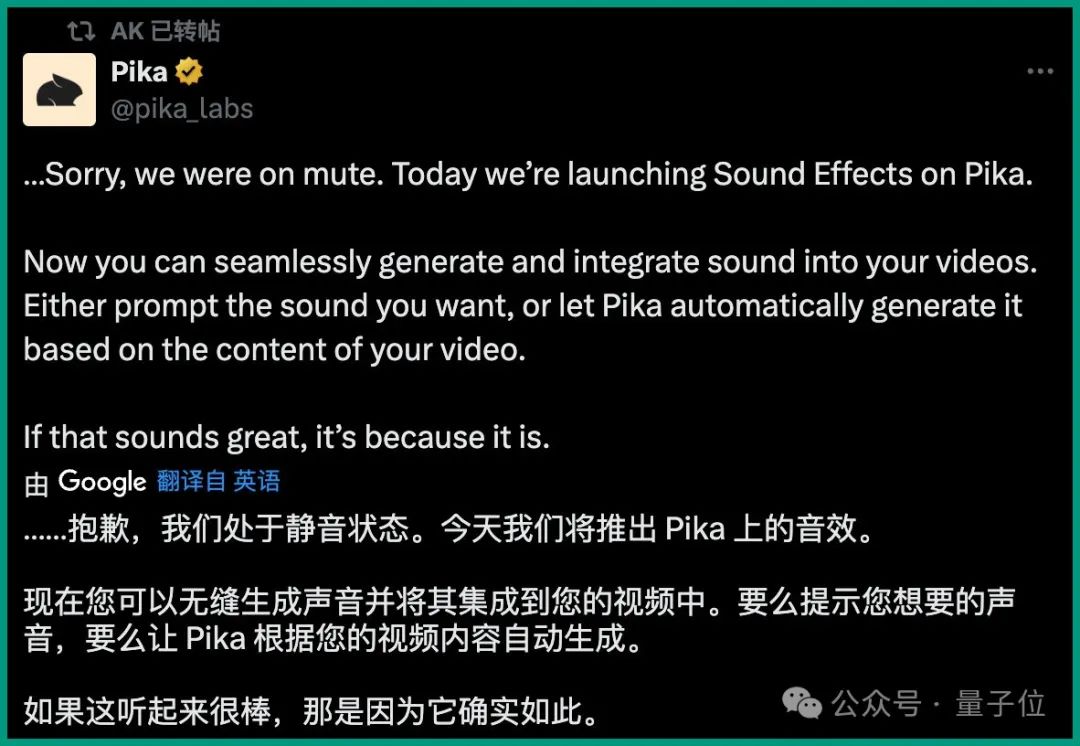
There are two ways to generate:
- Either give a prompt and describe the sound you want;
- Or Directly let Pika automatically generate it based on the video content.
And Pika said very confidently: "If you think the sound effect sounds great, that's because it is."
The sound of cars, radios, eagles, swords, cheers... it can be said that the sound is endless, and in terms of effect, it is also highly consistent with the video picture.
Not only has the promotional video been released, but Pika’s official website has also released multiple demos.
For exampleWithout any prompt, the AI just watched the video of roasting bacon and can match the sound effects without any sense of violation.
Another prompt:
Super saturated color, fireworks over a field at sunset.
Super saturated color, fireworks over a field at sunset.
Pika can generate video and add sound at the same time. It is not difficult to see from the effect that the sound stuck at the moment when the fireworks bloom is also quite accurate.
Such a new feature was released during the big weekend. While netizens were shouting Pika "It's so curly and awesome" , some people also thought:
It's collecting all the "infinity stones" for multi-modal AI creation.

So let’s continue to look at how to operate Pika’s Sound Effects.
“make some noise” for videos
Pika’s operation of generating sound effects for videos is also extreme! That! simple! one!
For example, with just one prompt, video and sound effects can be "produced in one pot":
Mdieval trumpet player .
Medieval trumpeter.

#Compared with the previous operation of generating video, now you only need to turn on the "Sound effects" button below.
The second method of operation is to dub it separately after generating the video.
For example, in the video below, click "Edit" below, and then select "Sound Effects":

Then you can describe the sound you want, for example:
Race car revving its engine.
The car is starting its engine.
Then in just a few seconds, Pika can generate sound effects based on the description and video, and there are 6 sounds to choose from!
It is worth mentioning that the Sound Effects function is currently only open for testing to Super Collaborator (Super Collaborator) and Pro users.
However, Pika also said: "We will launch this feature to all users soon!"
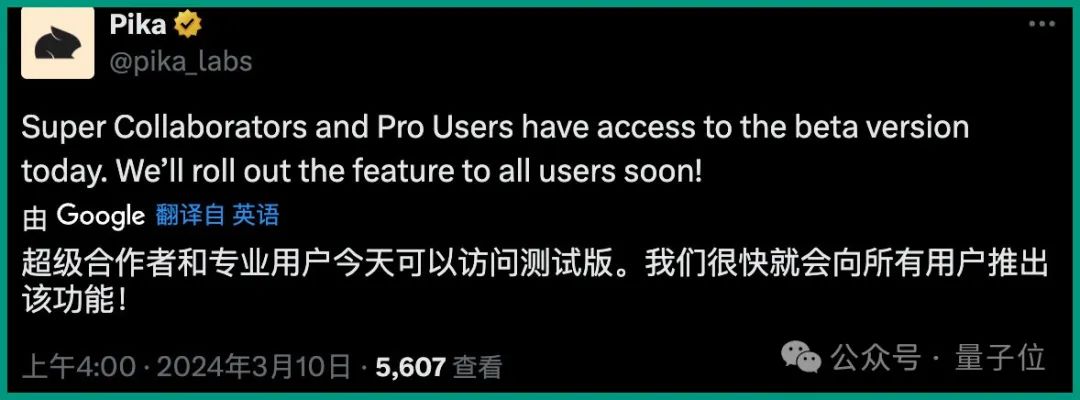
Now a group of netizens have started testing this Beta version and said:
The sound effects sound very suitable for the video and add a lot of atmosphere.
What is the principle?
As for the principle behind Sound Effects, although Pika has not made it public this time, after Sora became popular, the voice startup company ElevenLabs has produced a similar dubbing function.
At that time, NVIDIA senior scientist Jim Fan made a more in-depth analysis of this.
He believes that AI learning accurate video to audio mapping also requires modeling some "implicit" physics in the latent space.
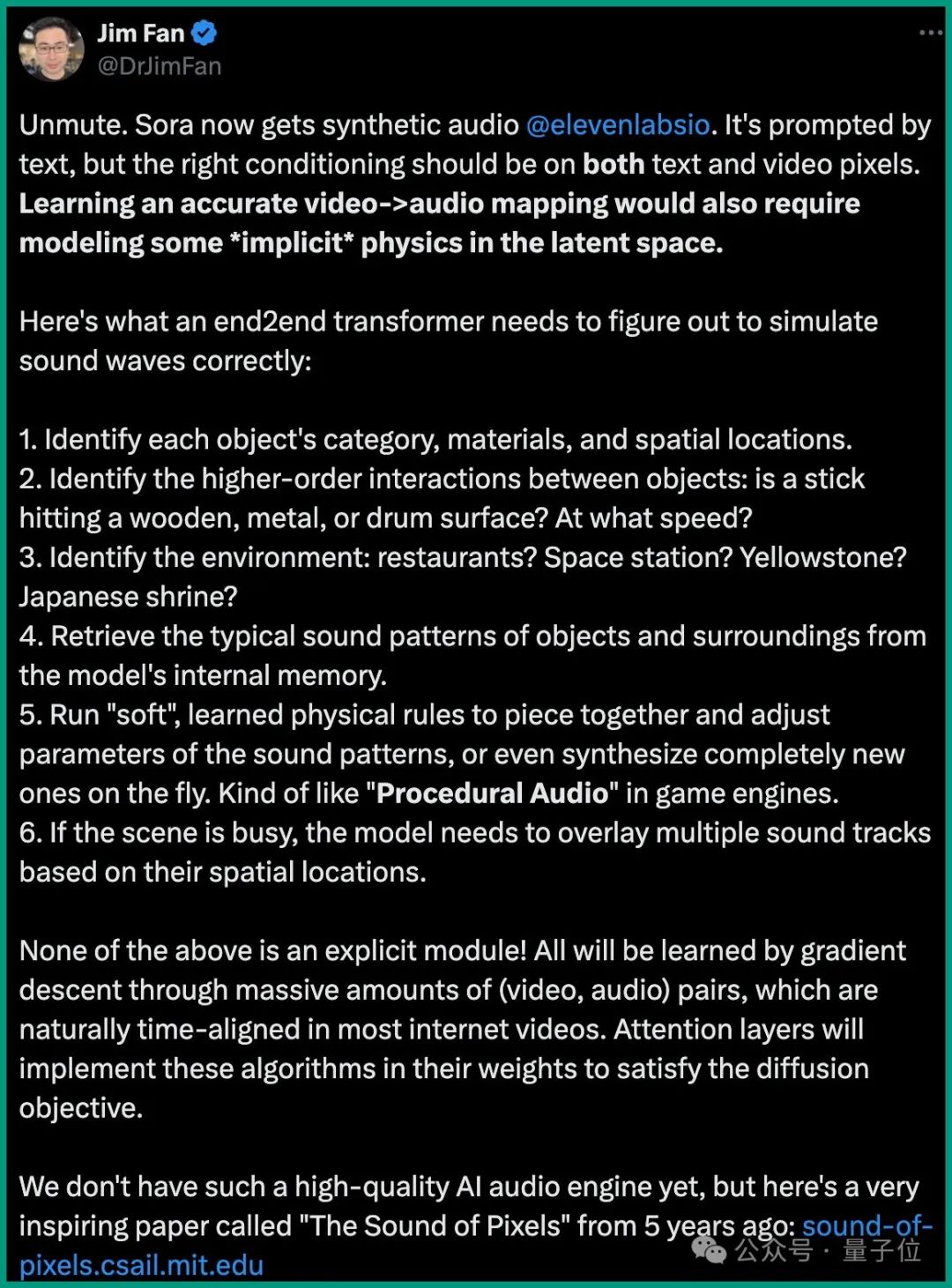
He detailed the problems that the end-to-end Transformer needs to solve when simulating sound waves:
- Identify the category, material and Spatial location.
- Recognize higher-order interactions between objects: For example, is it a stick, metal, or drumhead? At what speed does it hit?
- Identify the environment: Is it a restaurant, a space station, or Yellowstone Park?
- Retrieve typical sound patterns of objects and environments from the model's internal memory.
- Use "soft", learned physical rules to combine and adjust the parameters of sound patterns, and even create entirely new sounds on the fly. It's a bit like "procedural audio" in game engines.
- If the scene is complex, the model needs to superimpose multiple sound tracks according to the spatial position of the object.
All of this is not an explicit module, but is achieved by gradient descent learning from a large number of (video, audio) pairs, which are naturally found in most Internet videos. Time alignment. Attention layers will implement these algorithms in their weights to meet the diffusion goal.
In addition, Jim Fan said at the time that Nvidia’s related work did not have such a high-quality AI audio engine, but he recommended a paper from MIT five years ago The Sound of Pixels:
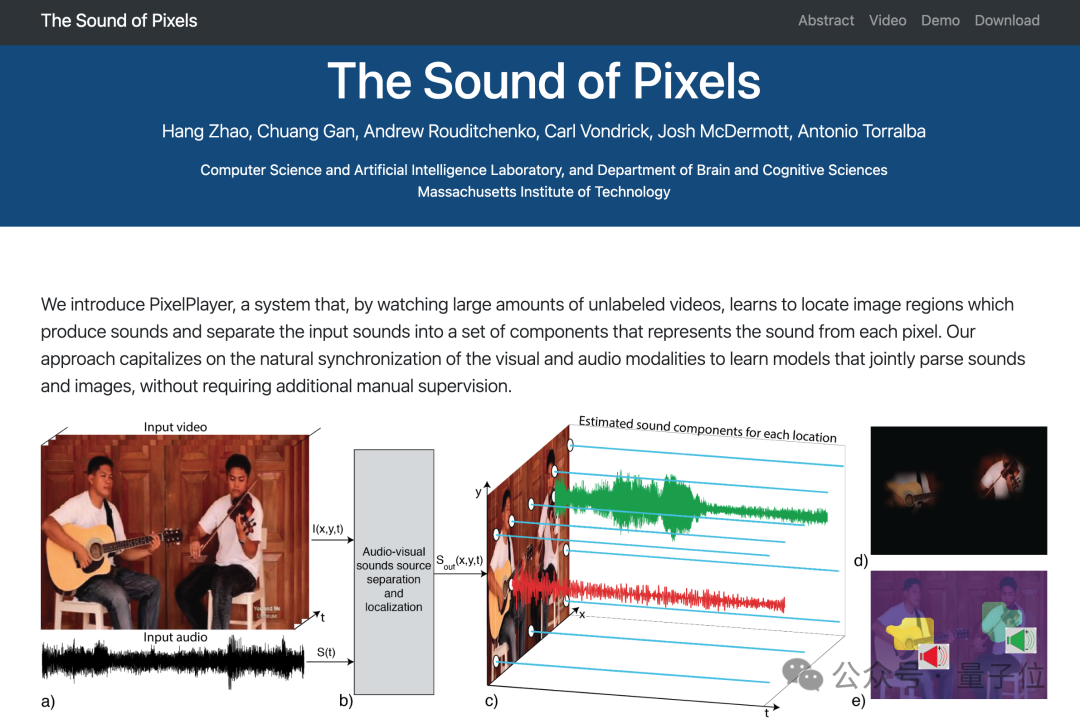
Interested friends can click on the link at the end of the article to learn more.
One More Thing
In terms of multimodal, LeCun’s views in the latest interview are also very popular. He believes:
Language (text) is low-bandwidth : less than 12 bytes/second. Modern LLMs typically use 1x10^13 double-byte tokens (i.e. 2x10^13 bytes) for training. It would take a human being approximately 100,000 years (12 hours a day) to read.
Visual bandwidth is much higher: about 20MB/s. Each of the two optic nerves has 1 million nerve fibers, each carrying about 10 bytes per second. A 4-year-old child spends about 16,000 hours in the awake state, which is about 1x10^15 when converted into bytes.
The data bandwidth of visual perception is approximately 16 million times that of text language data bandwidth.
The data a 4-year-old child sees is 50 times the largest LLM data for all text training publicly available on the Internet.
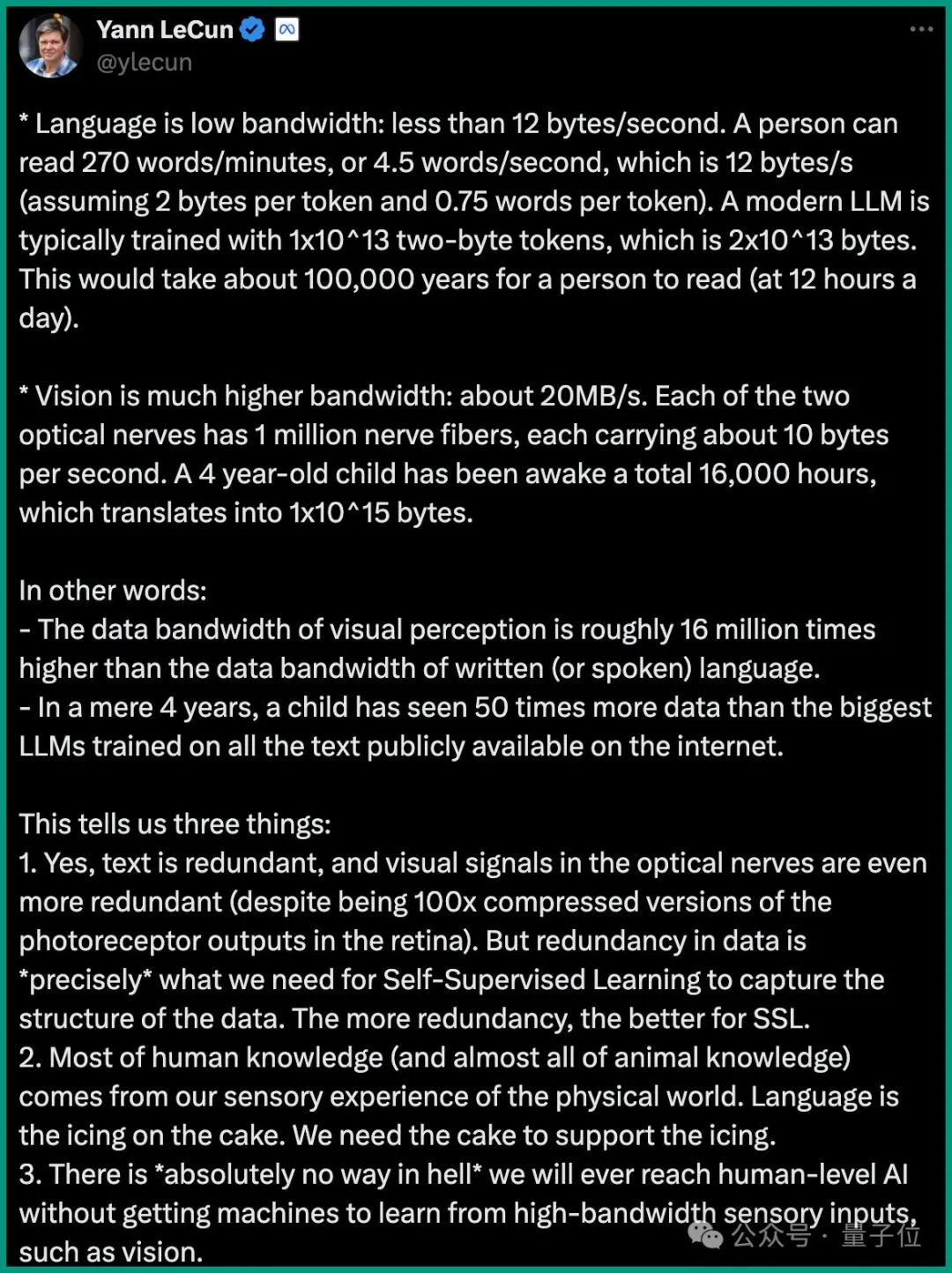
Thus, LeCun concluded:
If machines are not allowed to learn from high-bandwidth sensory input (such as vision), There is absolutely no way we can achieve human-level artificial intelligence.
So, do you agree with this view?
The above is the detailed content of Pika's amplification trick: starting from today, video and sound effects can be produced 'in one pot'!. For more information, please follow other related articles on the PHP Chinese website!

Hot AI Tools

Undresser.AI Undress
AI-powered app for creating realistic nude photos

AI Clothes Remover
Online AI tool for removing clothes from photos.

Undress AI Tool
Undress images for free

Clothoff.io
AI clothes remover

Video Face Swap
Swap faces in any video effortlessly with our completely free AI face swap tool!

Hot Article

Hot Tools

Notepad++7.3.1
Easy-to-use and free code editor

SublimeText3 Chinese version
Chinese version, very easy to use

Zend Studio 13.0.1
Powerful PHP integrated development environment

Dreamweaver CS6
Visual web development tools

SublimeText3 Mac version
God-level code editing software (SublimeText3)

Hot Topics
 1664
1664
 14
14
 1423
1423
 52
52
 1317
1317
 25
25
 1268
1268
 29
29
 1242
1242
 24
24
 Bytedance Cutting launches SVIP super membership: 499 yuan for continuous annual subscription, providing a variety of AI functions
Jun 28, 2024 am 03:51 AM
Bytedance Cutting launches SVIP super membership: 499 yuan for continuous annual subscription, providing a variety of AI functions
Jun 28, 2024 am 03:51 AM
This site reported on June 27 that Jianying is a video editing software developed by FaceMeng Technology, a subsidiary of ByteDance. It relies on the Douyin platform and basically produces short video content for users of the platform. It is compatible with iOS, Android, and Windows. , MacOS and other operating systems. Jianying officially announced the upgrade of its membership system and launched a new SVIP, which includes a variety of AI black technologies, such as intelligent translation, intelligent highlighting, intelligent packaging, digital human synthesis, etc. In terms of price, the monthly fee for clipping SVIP is 79 yuan, the annual fee is 599 yuan (note on this site: equivalent to 49.9 yuan per month), the continuous monthly subscription is 59 yuan per month, and the continuous annual subscription is 499 yuan per year (equivalent to 41.6 yuan per month) . In addition, the cut official also stated that in order to improve the user experience, those who have subscribed to the original VIP
 Context-augmented AI coding assistant using Rag and Sem-Rag
Jun 10, 2024 am 11:08 AM
Context-augmented AI coding assistant using Rag and Sem-Rag
Jun 10, 2024 am 11:08 AM
Improve developer productivity, efficiency, and accuracy by incorporating retrieval-enhanced generation and semantic memory into AI coding assistants. Translated from EnhancingAICodingAssistantswithContextUsingRAGandSEM-RAG, author JanakiramMSV. While basic AI programming assistants are naturally helpful, they often fail to provide the most relevant and correct code suggestions because they rely on a general understanding of the software language and the most common patterns of writing software. The code generated by these coding assistants is suitable for solving the problems they are responsible for solving, but often does not conform to the coding standards, conventions and styles of the individual teams. This often results in suggestions that need to be modified or refined in order for the code to be accepted into the application
 Seven Cool GenAI & LLM Technical Interview Questions
Jun 07, 2024 am 10:06 AM
Seven Cool GenAI & LLM Technical Interview Questions
Jun 07, 2024 am 10:06 AM
To learn more about AIGC, please visit: 51CTOAI.x Community https://www.51cto.com/aigc/Translator|Jingyan Reviewer|Chonglou is different from the traditional question bank that can be seen everywhere on the Internet. These questions It requires thinking outside the box. Large Language Models (LLMs) are increasingly important in the fields of data science, generative artificial intelligence (GenAI), and artificial intelligence. These complex algorithms enhance human skills and drive efficiency and innovation in many industries, becoming the key for companies to remain competitive. LLM has a wide range of applications. It can be used in fields such as natural language processing, text generation, speech recognition and recommendation systems. By learning from large amounts of data, LLM is able to generate text
 Can fine-tuning really allow LLM to learn new things: introducing new knowledge may make the model produce more hallucinations
Jun 11, 2024 pm 03:57 PM
Can fine-tuning really allow LLM to learn new things: introducing new knowledge may make the model produce more hallucinations
Jun 11, 2024 pm 03:57 PM
Large Language Models (LLMs) are trained on huge text databases, where they acquire large amounts of real-world knowledge. This knowledge is embedded into their parameters and can then be used when needed. The knowledge of these models is "reified" at the end of training. At the end of pre-training, the model actually stops learning. Align or fine-tune the model to learn how to leverage this knowledge and respond more naturally to user questions. But sometimes model knowledge is not enough, and although the model can access external content through RAG, it is considered beneficial to adapt the model to new domains through fine-tuning. This fine-tuning is performed using input from human annotators or other LLM creations, where the model encounters additional real-world knowledge and integrates it
 Five schools of machine learning you don't know about
Jun 05, 2024 pm 08:51 PM
Five schools of machine learning you don't know about
Jun 05, 2024 pm 08:51 PM
Machine learning is an important branch of artificial intelligence that gives computers the ability to learn from data and improve their capabilities without being explicitly programmed. Machine learning has a wide range of applications in various fields, from image recognition and natural language processing to recommendation systems and fraud detection, and it is changing the way we live. There are many different methods and theories in the field of machine learning, among which the five most influential methods are called the "Five Schools of Machine Learning". The five major schools are the symbolic school, the connectionist school, the evolutionary school, the Bayesian school and the analogy school. 1. Symbolism, also known as symbolism, emphasizes the use of symbols for logical reasoning and expression of knowledge. This school of thought believes that learning is a process of reverse deduction, through existing
 To provide a new scientific and complex question answering benchmark and evaluation system for large models, UNSW, Argonne, University of Chicago and other institutions jointly launched the SciQAG framework
Jul 25, 2024 am 06:42 AM
To provide a new scientific and complex question answering benchmark and evaluation system for large models, UNSW, Argonne, University of Chicago and other institutions jointly launched the SciQAG framework
Jul 25, 2024 am 06:42 AM
Editor |ScienceAI Question Answering (QA) data set plays a vital role in promoting natural language processing (NLP) research. High-quality QA data sets can not only be used to fine-tune models, but also effectively evaluate the capabilities of large language models (LLM), especially the ability to understand and reason about scientific knowledge. Although there are currently many scientific QA data sets covering medicine, chemistry, biology and other fields, these data sets still have some shortcomings. First, the data form is relatively simple, most of which are multiple-choice questions. They are easy to evaluate, but limit the model's answer selection range and cannot fully test the model's ability to answer scientific questions. In contrast, open-ended Q&A
 SK Hynix will display new AI-related products on August 6: 12-layer HBM3E, 321-high NAND, etc.
Aug 01, 2024 pm 09:40 PM
SK Hynix will display new AI-related products on August 6: 12-layer HBM3E, 321-high NAND, etc.
Aug 01, 2024 pm 09:40 PM
According to news from this site on August 1, SK Hynix released a blog post today (August 1), announcing that it will attend the Global Semiconductor Memory Summit FMS2024 to be held in Santa Clara, California, USA from August 6 to 8, showcasing many new technologies. generation product. Introduction to the Future Memory and Storage Summit (FutureMemoryandStorage), formerly the Flash Memory Summit (FlashMemorySummit) mainly for NAND suppliers, in the context of increasing attention to artificial intelligence technology, this year was renamed the Future Memory and Storage Summit (FutureMemoryandStorage) to invite DRAM and storage vendors and many more players. New product SK hynix launched last year
 SOTA performance, Xiamen multi-modal protein-ligand affinity prediction AI method, combines molecular surface information for the first time
Jul 17, 2024 pm 06:37 PM
SOTA performance, Xiamen multi-modal protein-ligand affinity prediction AI method, combines molecular surface information for the first time
Jul 17, 2024 pm 06:37 PM
Editor | KX In the field of drug research and development, accurately and effectively predicting the binding affinity of proteins and ligands is crucial for drug screening and optimization. However, current studies do not take into account the important role of molecular surface information in protein-ligand interactions. Based on this, researchers from Xiamen University proposed a novel multi-modal feature extraction (MFE) framework, which for the first time combines information on protein surface, 3D structure and sequence, and uses a cross-attention mechanism to compare different modalities. feature alignment. Experimental results demonstrate that this method achieves state-of-the-art performance in predicting protein-ligand binding affinities. Furthermore, ablation studies demonstrate the effectiveness and necessity of protein surface information and multimodal feature alignment within this framework. Related research begins with "S



